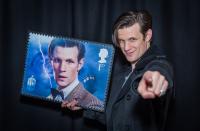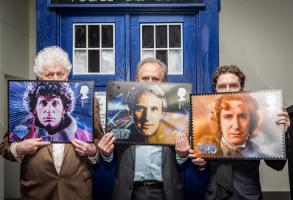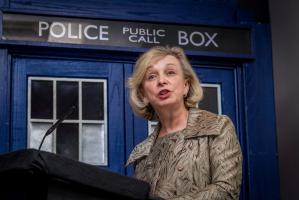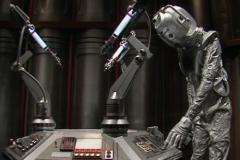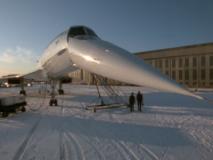 The eighth in our series of features looking at events leading to the creation of a true TV legend. The story so far: Sydney Newman, the new Head of Television Drama at the BBC has asked the Script Department to come up with ideas for a new science-fiction series that would not not only bridge the gap on Saturday evenings between Grandstand and the pop music show Juke Box Jury but also appeal to both audiences.
The eighth in our series of features looking at events leading to the creation of a true TV legend. The story so far: Sydney Newman, the new Head of Television Drama at the BBC has asked the Script Department to come up with ideas for a new science-fiction series that would not not only bridge the gap on Saturday evenings between Grandstand and the pop music show Juke Box Jury but also appeal to both audiences.It was on
26th March 1963 - exactly 50 years ago today - that four people convened in an office in Television Centre to lay down the ground rules for the series that would develop, eight months later, into
Doctor Who.
Donald Wilson chaired the meeting in his role as Head of the Script Department, and it took as its starting point the reports on science-fiction compiled the previous year by the Survey Group, whose authors,
John Braybon and
Alice Frick, were present. They were joined by a fourth member of the script department,
Cecil Edwin Webber.

Better known by the nickname "Bunny", Cecil Webber was an established playwright with credits on the stage and screen. His published stage plays had included
Be Good, Sweet Maid in 1957 and
Out of the Frying Pan in 1960, while for television he had written the 1961 action-adventure serial
Hurricane and in 1962 the children's comedy
William, which starred
Dennis Waterman in one of his earliest roles and was adapted from some of the
Just William books by
Richmal Crompton.
The meeting set out to lay down some ground rules for the series, with discussions ranging from the practical to the esoteric and with concepts such as the nature of energy and the persistence of human thought being debated. Many ideas were put forward, with all agreeing that around seven or eight ideas would be needed to make enough stories to fill a 52-week series.
Some discussion was held over the type of craft to be used in the series. As detailed in a subsequent report by Frick, Wilson thought that if a time machine was used it should be able to travel not only backwards and forwards in time but also into all kinds of matter such as a drop of oil or under the sea. Meanwhile, Frick thought it might be more modern to feature a flying saucer carrying the regular cast of characters from story to story. Wilson was anxious to avoid the use of a computer as this was the main plot device in the BBC's
Andromeda TV series of 1961 and 1962. Braybon wanted the series set in the future and suggested it featured a set of scientific trouble-shooters. It was also thought that the series should feature telepathy as a good plot device.
Wilson was keen that the series should feature a regular cast of characters. He felt this was important to build audience loyalty and said that two young teenagers should be included in the team, given the time slot the series would be aimed at. Frick felt that children of school age were more interested in characters older than themselves and suggested someone in their early-20s, something with which Webber and Braybon agreed.
The meeting ended with Frick tasked with making a report and Webber commissioned to write up a list of viable characters for the series, based on the discussion, and an outline set-up.
The concept Webber came up with and documented in a memo just three days later was for a series set around "The Troubleshooters", a group of three scientists who tackle problems that no-one else could handle. The drama would have three main characters to lead viewers through a series of stories each running for around 7 weeks. Although the series finally produced would be very different in style and concept to this first draft, the genesis of the character of The Doctor can clearly be seen in the outline for the Troubleshooters and in particular in the character of the third lead.
Memo from C.E. Webber to Donald Wilson. 29th March 1963 Characters and SetupEnvisaged is a "loyalty programme", lasting at least 52 weeks, consisting of various dramatised S.F. stories, linked to form a continuous serial, using basically a few characters who continue through all the stories. Thus if each story were to run six or seven episodes there would be about eight stories needed to form fifty-two weeks of the overall serial.
Our basic setup with its loyalty characters must fulfil two conditions:-
- It must attract and hold the audience.
- It must be adaptable to any S.F. story, so that we do not have to reject stories because they fail to fit into our setup.
Suitable characters for the five o'clock Saturday audience.
Child characters do not command the interest of children older than themselves. Young heroines do not command the interest of boys. Young heroes do command the interest of girls. Therefore, the highest coverage amongst children and teenagers is got by:-
THE HANDSOME YOUNG MAN HERO (First character)
A young heroine does not command the full interest of older women; our young hero has already got the boys and girls; therefore we can consider the older woman by providing:-
THE HANDSOME WELLDRESSED HEROINE AGED ABOUT 30 (Second character)
Men are believed to form an important part of the 5 o'clock Saturday (post-Grandstand) audience. They will be interested in the young hero; and to catch them firmly we should add:-
THE MATURER MAN, 35 - 40, WITH SOME "CHARACTER" TWIST. (Third character)
Nowadays, to satisfy grown women, father-figures are introduced into loyalty programmes at such a rate that TV begins to look like an Old People's Home: let us introduce them ad hoc, as our stories call for them. We shall have no child protoganists [sic], but child characters may be introduced ad hoc, because story requires it, not to interest children.
What are our three chosen characters?The essence of S.F. is that the wonder or fairytale element shall be given a scientific or technical explanation. To do this there must be at least one character capable of giving the explanation, and I think that however we set up our serial, we must come around to at least one scientist as a basic character. I am now suggesting that all three be Scientists, though handsome and attractively normal people. Such vague cliches as Government Project, Secret Research, Industrial Atomics, Privately Financed Laboratory in Scotland, do not
necessarily involve our group in every kind of S.F. story presented to us. Therefore I suggest that they are, all three,
THE PARTNERS IN A FIRM OF SCIENTIFIC CONSULTANTS.They are a kind of firm which does not exist at present, being an extension of today's industrial consultant into the scientific era. We are in a time which is not specified but which is felt to be just a bit ahead of the present; but the wonder is introduced into today's environment. The firm carry on normal lines of research in their own small laboratory, or in larger ones elsewhere if the job requires it; this is their bread and butter; but they are always willing to break off to follow some more unusual case. In fact, they have a reputation for tackling problems which no-one else could handle; there is almost a feeling of Sherlock Holmes about this side of their work. Our stories are the more unusual cases which come their way. This setup gives us fluidity for an everlasting serial. One, or two, of them can persue [sic] a story, leaving at least one behind to start on the next case when we need to transfer to another story. They are:-
"THE TROUBLESHOOTERS"Each of them is a specialist in certain fields, so that each can bring a different approach to any problem. But they are all acutely conscious of the social and human implications of any case, and if the two men sometimes become pure scientist and forget, the woman always reminds them that, finally, they are dealing with human beings. Their Headquarters or Base illustrates this dichotomy: it consists of two parts: 1. a small lab fitted with way-out equipment, including some wondrous things acquired in previous investigations and 2. an office for interviews, homely, fusty, comfortable, dustily elegant: it would not have been out of place in Holmes's Baker Street.
Villains.It would be possible to devise a permanent villain for the above "Troubleshooters" setup. Our heroes find themselves always coming up against him in various cases: the venal politician who seeks to use every situation to increase his own power; or the industrialist always opposing our heroes. Possibly some continuing villain may create himself as we go, but I suggest that we create ad hoc villains for each story, as needed. It is the Western setup in this respect: constant heroes, and a fresh villain each time.
Overall Meaning of the Serial.We shall have no trouble in finding stories. The postulates of S.F., from which its plots derive, can be broadly classified, even enumerated; and we all have additions or startling variations up our sleeves. But I think we might well consider if there is any necessary difference between the dramatic and the literary form, as regards S.F.
- a. S.F. deliberately avoids character-in-depth. In S.F. the characters are almost interchangable. We must use fully conceived characters.
- b. S.F. is deliberately unsexual; women are not really necessary to it. We must add feminine interest as a consequence of creating real characters.
- c. Because of the above conditions, S.F. does not consider moral conflict. It has one clear overall meaning: that human beings in general are incapable of controlling the forces they set free. But once we have created real characters, we must consider the implications in terms of those characters in their society. Drama is about moral conflicts: it is about social relationships. Experienced S.F. writers may disagree with me. Well, let them create their own live S.F. drama. But for me, it seems a fine opprtunity to write fastmoving, shocking episodes, which necessarily consider, or at least firmly raise, such questions as: What sort of people do we want? What sort of conditions do we desire? What is life? What are we? Can society exist without love, without art, without lies, without sex? Can it afford to continue to exist with politicians? With scientists? And so on.
The final section mirrored the 1962 reports, which had emphasised that TV science-fiction ought to lean more towards being character-based than had been the case in literature, that it would need the addition of "feminine interest", and that philosophical or moral questions needed to be at least firmly raised if not considered.
The day after the meeting - on
27th March 1963 - a memo was sent by
John Mair, the senior planning assistant responsible for allocating TV studio time, to
Joanna Spicer, the Assistant Controller (Planning) Television, asking her for details about the planned new series.
Webber's memo was attached to Frick's report (as mentioned above), the latter of which read in full as follows:
The following devices were discussed:
1. Time Machine: Donald Wilson suggested if this were used, it should be a machine not only for going forward and backwards in time, but into space, and into all kinds of matter (e.g. a drop of oil, a molecule, under the ocean, etc.)
2. Flying Saucer: Alice Frick thought this might be a more modern vehicle than a time machine, much discussed at present, and with a considerable body of literature concerning it. It would have the advantage of conveying a group of people (i.e. the regular cast of characters).
3. Computer: Donald Wilson thought this should be avoided, since it was the Andromeda device.
4. Telepathy: This is an okay notion in modern science, and a good device for dealing with outer-space inhabitants who have appropriated human bodies (e.g. Three To Conquer by Eric Frank Russell).
5. John Braybon suggested that the series should be set in the future, and that a good device would be a world body of scientific trouble-shooters, established to keep scientific experiments under control for political or humanistic reasons.
A good many possible (and probably some impracticable!) ideas for themes and content were discussed, among them some published works - Guardians of Time by Poul Anderson and Three To Conquer by Russell.
Some recent scientific discoveries or developments whose uses are still not known nor explored were mentioned, e.g. the Laser Beam. We all thought that the use of seven or eight such "new" ideas, one for each short serial, could make a 52-week series.
Bunny Webber brought forward the idea of the continuance of thought; the idea that great scientists of the past might continue in some form of existence and could be contacted to discover further advances they had made, ideas they might bring to current discoveries, thought, etc.
Donald Wilson introduced a discussion of human creativity, the presence in the world of the human capacity to initiate original thought, to create new concepts, ideas, etc, the immeasurable and inexplicable work and productivity of genius. This led on to a discussion of energy, the difference between scientific energy, which can be measured, and human energy, which cannot.
Donald Wilson said that the series must be based on a group of regular characters, some of whom would be employed in major roles in one limited serial, others in the next, according to the needs of the different stories. He felt this was essential to establishing a loyalty audience. He suggested that, for the time-slot, two young teenagers should be included. Alice Frick advanced the opinion that children of that age were more interested in characters who are older than themselves, in the early twenties. Braybon and Webber supported this idea. Young children could be introduced occasionally, but should not be among the regulars.
The major problems in format are, how to involve a part of a permanent group in widely differing adventures, and how to transport them believably to entirely disparate milieux.
The following month would see Newman responding to Webber's memo and Frick's report, pushing the team more towards how he envisaged the series, and his annotations to the memo can be clearly seen.
Compiled by:
Marcus and John Bowman
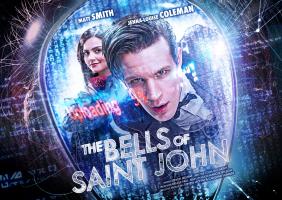 Final ratings data for the week ending 31st March 2013 released by the Broadcasters’ Audience Research Board, or BARB, gives Doctor Who: The Bells of Saint John a final rating of 8.44 million viewers.
Final ratings data for the week ending 31st March 2013 released by the Broadcasters’ Audience Research Board, or BARB, gives Doctor Who: The Bells of Saint John a final rating of 8.44 million viewers. 
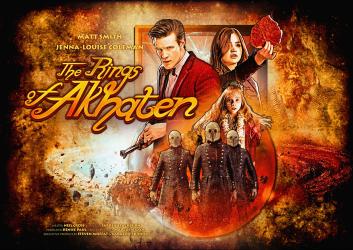


 Seemingly immortal, 50-years-old and still running, this engaging, imaginative sci-fi/fantasy series is awarded an Institutional Peabody for evolving with technology and the times like nothing else in the known television universe.
Seemingly immortal, 50-years-old and still running, this engaging, imaginative sci-fi/fantasy series is awarded an Institutional Peabody for evolving with technology and the times like nothing else in the known television universe.
 The eighth in our series of features looking at events leading to the creation of a true TV legend.
The eighth in our series of features looking at events leading to the creation of a true TV legend. Better known by the nickname "Bunny", Cecil Webber was an established playwright with credits on the stage and screen. His published stage plays had included Be Good, Sweet Maid in 1957 and Out of the Frying Pan in 1960, while for television he had written the 1961 action-adventure serial Hurricane and in 1962 the children's comedy William, which starred Dennis Waterman in one of his earliest roles and was adapted from some of the Just William books by Richmal Crompton.
Better known by the nickname "Bunny", Cecil Webber was an established playwright with credits on the stage and screen. His published stage plays had included Be Good, Sweet Maid in 1957 and Out of the Frying Pan in 1960, while for television he had written the 1961 action-adventure serial Hurricane and in 1962 the children's comedy William, which starred Dennis Waterman in one of his earliest roles and was adapted from some of the Just William books by Richmal Crompton.



